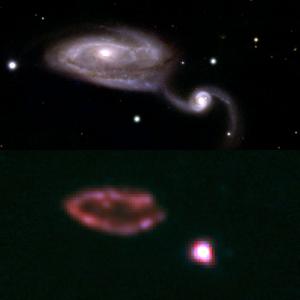An international team of astronomers has used the Herschel Space Observatory to take far-infrared images of the 200 most infrared-luminous galaxies in the local universe. Initially cataloged by the NASA Infrared Astronomical Satellite (IRAS) in 1984 as part of the first all-sky survey at far-infrared wavelengths, these galaxies are thought to be forming stars up to 100 times faster than normal galaxies such as the Milky Way, as well as growing super massive black holes at their centers.
These exotic sources have been the subject of intense observational study with nearly all of the world’s ground-based and space observatories, and the data are being made available to the public as part of the Great Observatories All-Sky LIRG Survey (GOALS). Optical observations of the 200 GOALS sources have clearly shown that rather than being a single “normal” galaxy, the majority of these sources are actually merging galaxy pairs with highly distorted structures, including regions of intense star formation as well as regions of heavy dust obscuration. The new observations by Herschel are allowing astronomers to construct a clearer picture of the gas and dust that provides the fuel for the enormous energy output that will eventually help reshape these objects.
Astronomers have long known that the Milky Way Galaxy will collide with its closest neighbor, the Andromeda Galaxy, in the distant future. Just as how Newton realized that the Earth’s gravitational pull causes objects to fall to the ground, the mutual gravitational pull between the Milky Way and Andromeda galaxies will produce a spectacular collision approximately 4 billion years in the future.
But what do galaxy collisions on a grand scale look like, without waiting billions of years to find out? To answer this question the GOALS team, including graduate student Jason Chu and Dr. David Sanders from the University of Hawaiʻi’s Institute for Astronomy (IfA), have been looking at other galaxies in the universe to find out. Before they collide galaxies are typically disk or spiral shaped, much like what the Andromeda Galaxy looks like right now. “But when galaxies collide, tens of billions of stars from each galaxy are thrown around from the extreme gravitational tidal disruptions, and these merging galaxies can appear as anything from warped disks to a cosmic train wreck,” says lead author Chu, who is presenting the team’s findings at this week’s meeting of the American Astronomical Society in Austin, Texas.
These types of major mergers, where two very large gas-rich spiral galaxies collide, were first discovered in the mid-20th century. Astronomers now know these kinds of events can rapidly change the properties of the progenitor galaxies. “In fact many of these galaxies become extremely luminous at far-infrared wavelengths, beyond the visible light humans can see,” said Dr. Sanders. The elevated far-infrared luminosity is largely due to the intense heating of dust in merging galaxies. Two factors, a rapid increase in star formation and a dramatic surge in black hole feeding at the centers of both galaxies, produces the radiation that heats the dust.
The problem, though, was astronomers didn’t know by how much brighter in the far-infrared these galaxies become when they collide, although previous studies have attempted to estimate this by using lower resolution far-infrared brightnesses, or higher resolution near-infrared brightnesses. However the drawback with the first solution is that the low-resolution data means it’s easy to inadvertently include brightnesses from other unrelated objects, which would bias the measurement. In the latter case where near-infrared data is used, it was found that it is not always a good predictor of far-infrared brightnesses.
The solution was to observe these luminous infrared galaxies (LIRGs) using a high resolution, far-infrared telescope. Since the Earth’s atmosphere blocks all far-infrared light, this wasn’t possible until Herschel was launched in 2009. “Herschel is the last in a long line of famous infrared missions and it has allowed us to better characterize the energy output of LIRGs,” said Dr. Sanders. According to Chu, “By observing at six different wavelengths in the far-infrared, we now have a complete, high resolution picture of what these galaxies look like. These are the highest resolution data on LIRGs for the next decade or longer. By combining data from other space missions at shorter infrared wavelengths, we now have a complete infrared picture on the importance of star formation, black hole activity, and just how much of this activity is hidden from view by dust.” The team targeted all 200 objects in GOALS which constitute the nearest LIRGs to Earth, with the resulting far-infrared atlas published in the Astrophysical Journal Supplement series.
“There are already some exciting results coming out of the Herschel dataset,” said Dr. Sanders. “For instance, we discovered that the energy output at different far-infrared wavelengths was a little different than previously thought. But not only that, we can now accurately calculate several important galaxy properties, such as the average dust temperatures and dust masses in these galaxies, and more accurate star formation rates at smaller spatial scales. Plus we are confirming that most of the rapid growth phase of super-massive black holes is largely hidden from view in the optical by enormous columns of gas and dust.” Furthermore, the published data will enable other researchers to compare the GOALS sample to more distant LIRGs where they are much more common, and thus reveal any evolutionary trends through cosmic history.
The work appears in the April 2017 issue of the Astrophysical Journal Supplement Series, and can be found online at http://iopscience.iop.org/0067-0049/229/2/25/.


